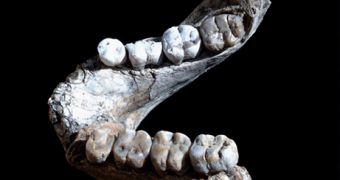The famous Lucy did not come from nowhere. She had a grandfather, and recently discovered jawbones of that species, dug in northeast Ethiopia, could explain more on a virtually unknown period of human evolution. The new bones were discovered in the same fossil-rich Afar region, just 20 mi (32 km) north of the site where "Lucy", a 3.2 million years old human was dug up in 1974.
The new bones could be 3.8 million to 3.5 million years old and could fill the gap between Australopithecus anamensis, which lived some 4.2 million to 3.9 million years ago, and Australopithecus afarensis (Lucy's species) that lived 3.6 million to 3 million years ago.
A. anamensis was suspected to be the ancestor of all the later Australopithecus species, and these new jawbones could solve the issue. "This will help us test this very hypothesis and see if we can falsify it or prove it. We have had isolated teeth and [other skeleton parts] from previous years. What we didn't have was a complete jaw, which we have now," said lead researcher Yohannes Haile-Selassie, head of physical anthropology at the Cleveland Museum of Natural History in Ohio. "Along with the jawbone, the team has also uncovered more than 30 or 40 specimens to further test the hypothesis," Haile-Selassie noted.
The jawbone could explain many issues, as while A. anamensis possessed large canine teeth and a narrow jaw (more ape style), Lucy had widened jaws, smaller canines and larger molars (more human like), thus she chewed rather than tore her food.
Another issue to be clarified is: how many branches of human ancestors existed during human evolution? Did some evolve into dead ends and disappeared?
"People are prepared to accept that there's diversity. But of course what is uncertain is how widespread it was (from the moment we split off chimps, about 4 million years ago)" said Chris Stringer, a research leader at London's Natural History Museum, not involved in the latest work. "If we had a complete fossil record, would we see branching events right through that period of time ... or were there only specific times of branching events?" Stringer said.
The Afar Depression has delivered several of the most significant fossil finds, from the earliest examples of human-chimp common ancestors, 5.8 million years old, to early anatomically modern human from 160,000 years ago. Three years of diggings in the area revealed over 1,900 vertebrate specimens, from human ancestors belonging to various periods, to mice, elephants, monkeys, rhinoceros, primitive horses, and fish.
"We will need some time to study the bones and come up with conclusions about the relationship between A. anamensis and A. afarensis. Two years down the line we may be able to say something about it," said Haile-Selassie.

 14 DAY TRIAL //
14 DAY TRIAL //